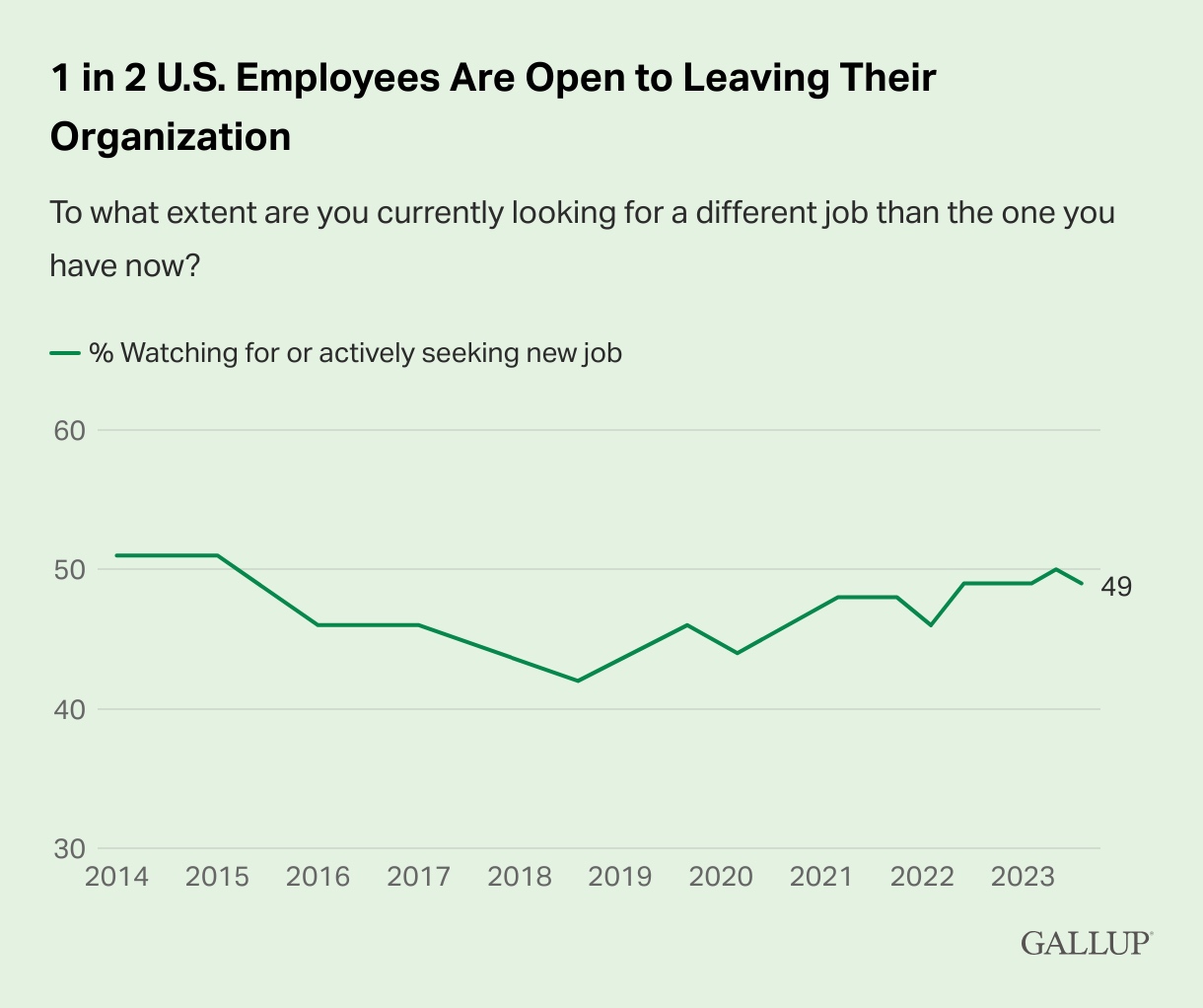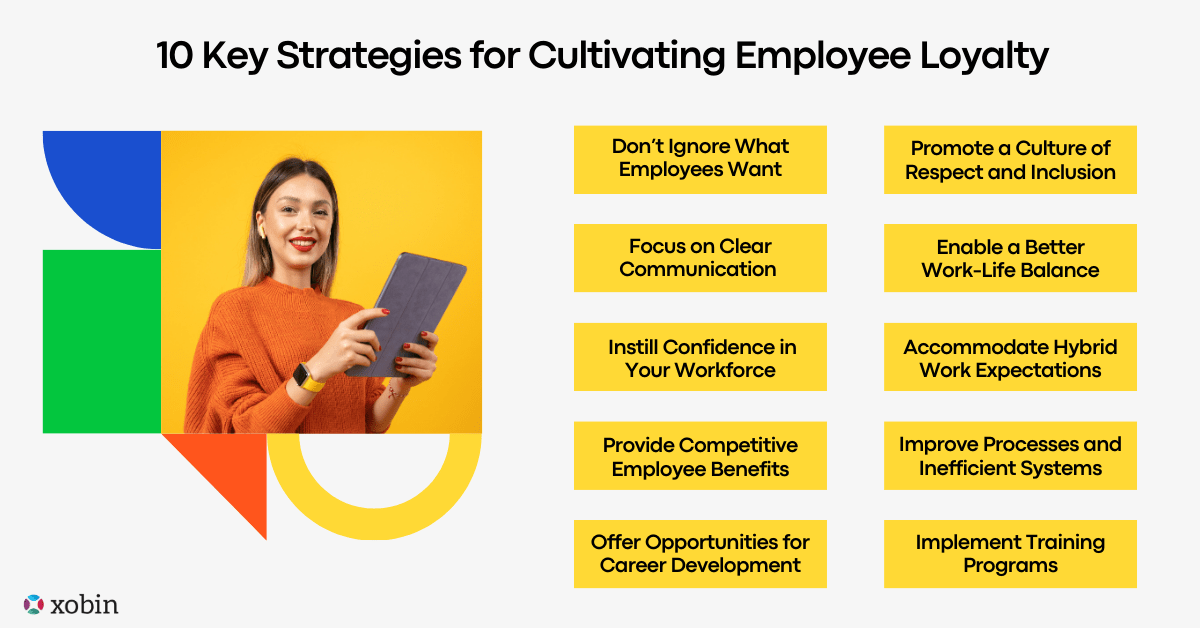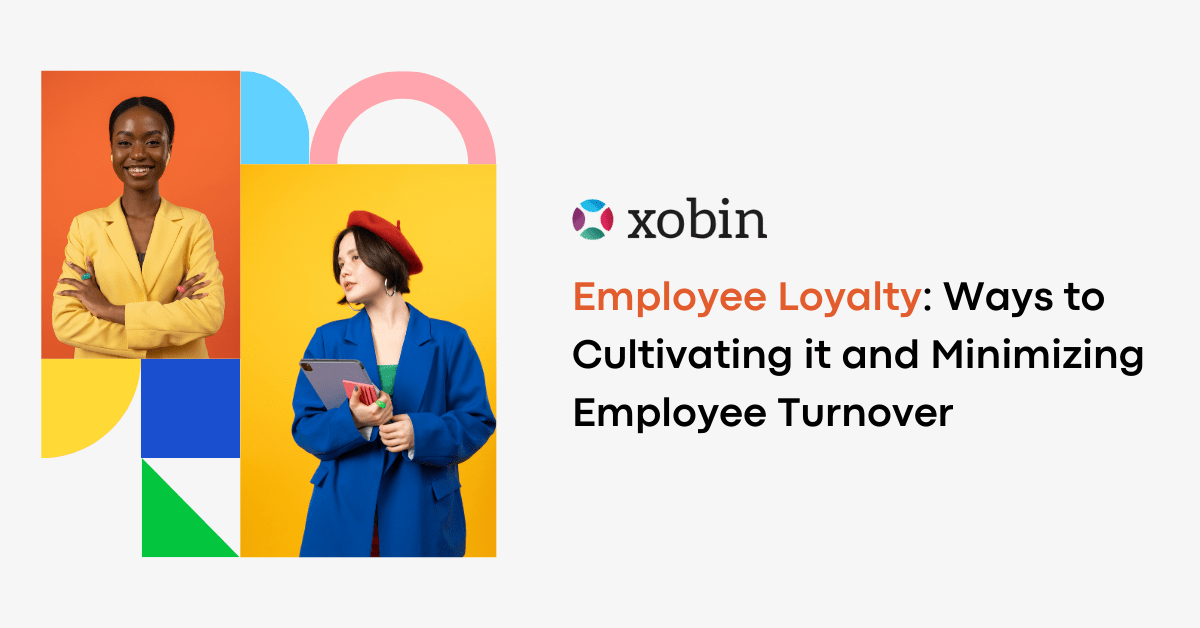Employees have the potential to be your best brand ambassadors or your worst critics. Brand ambassadors will manifest and foster employee loyalty, while critics will likely seek better job opportunities. According to Gallup, 50% of U.S. employees will happily leave an organization if they find a “better” job. At the same time, many employees say they would stay if employers improved workplace engagement with tools like automated video interviews to create a more seamless and positive hiring experience.
Table of Contents
Gallup has created an explicit graph (below) that indicates retention and attraction trends. It shows how the percentage of employees who were watching out for new jobs between 2014 and 2023 has dropped and risen again over time. Their data shows, more specifically, that in 2014, 51% of employees were intending to leave their jobs. This figure dropped to its lowest level (42%) in 2018. It then fluctuates, showing an upward trend through 2022 and 2023, rising to 49% from June 2022 and then 50% by May 2023, before dropping back down to 49%.
According to Bureau of Labor statistics, while the annual turnover or separations rate was 26.3% in 2017, it had risen to 47.2% by 2021. These figures include voluntary quits and involuntary separations. Bureau of Labor statistics also show that in 2022, quits accounted for 70% of total U.S. job separation. This amounted to 50.6-million employees, which is a huge volume in terms of employee turnover.
HR departments address turnover issues by implementing a variety of suitable strategies. Typically these will increase internal communication and improve employee engagement. Ultimately, they aim to create a positive work environment that is designed to promote employee retention.
How Does Employee Loyalty Relate to Employee Turnover?
Employee loyalty refers to a deep and enduring commitment that employees have towards their employer or organization. Their loyalty indicates that they are dedicated, engaged, and emotionally attached to their work, colleagues, and the company itself. Loyalty is often demonstrated by employees who consistently go above and beyond their job requirements, remain with the organization for an extended period, and actively promote the company’s interests.
Employee turnover rates indicate the percentage of employees who leave organizations within a specific timeframe. They are related to employee retention rates that measure the ability of organizations to retain employees over a given period of time. Employee loyalty has a positive impact on employee retention, helping to minimize turnover.
Why is Employee Loyalty Important?
Employee loyalty can affect your bottom line in ways that are hard to quantify. When you haven’t given your employees reasons to stick around, you’ll find that retention will suffer. And when people leave, there are subtle things that will fall through the cracks — affecting your productivity and revenue. It’s hard to put a number on institutional knowledge and familiarity, but this is one area that can negatively impact your teams when subject matter experts or people familiar with internal processes leave your organization. Having to figure out new processes, tech debt, and best practices without these experienced members makes life harder for all team members. The easy solution? Invest in employee experience, and you’ll see greater employee loyalty.
Employee loyalty is a critical factor in creating engaged workplaces and promoting sales performance. When team members feel valued, they contribute more to the overall success of the company, leading to an improved employee experience index, performance, productivity, and customer loyalty. It also involves creating an environment where employees feel satisfied and enthusiastic about their work. Young people, especially Gen Zers, are seeking more than just a paycheck. They want an employer who values and invests in their growth.

A single employee’s replacement might cost anywhere between a half and twice their annual compensation, according to Gallup. Loyal employees save money because they stay longer, reducing the need to constantly hire and train new staff. This means less spending on recruitment and training, freeing up resources for other important needs, while also ensuring a stable and knowledgeable workforce. Examining the impact of weaker retention, Harvard Business Review assesses that a company with 100 employees could lose up to $2.6-million in one year in turnover costs.
10 Key Strategies for Cultivating Employee Loyalty
There are many strategies that you can use to cultivate employee loyalty. A lengthy Qualtrics report on 2023 Employee Experience Trends shows how these trends are redefining the way employees and employees think about work. The key, it says, is to set a more human-centric perspective. At the same time, as the Gallup 2023 Guide to Engaging and Retaining Employees points out, there are many factors that you cannot control. With all of this in mind, we’re going to focus on 10 key strategies that will help you improve employee engagement and minimize employee turnover.
Don’t Ignore What Employees Want
Qualtrics defines the global voice of employees. For example, they want fair pay and benefits rather than a “cool office culture” if they are to stay in an organization. They want personal boundaries to be respected rather than being faced with a culture where “overwork” is the standard. Instead of more wellness benefits, they want processes and systems that reduce workload.
Employees value organizations that share a commitment to their future career and aren’t happy when things are uncertain. Ultimately, employees want to work in an organization that has the integrity to demonstrate and live its values. They don’t want values to be compromised when times get tough.
Focus on Clear Communication and Recognition
Internal communication platforms can provide easy communication paths that boost employee engagement. Regular feedback and recognition for the hard work of team members create an environment where employees feel appreciated which encourages loyalty. Show your employees that you care about them.
The Gallup research shows that most employees who decided to leave had never had a conversation with employers until this point. The value of employee engagement can never be overestimated. It’s essential for managers to communicate with employees in a meaningful way. If you don’t ask about their aspirations and passions, and where they want their careers to lead, they will think you don’t care. It’s certainly not going to inspire employee loyalty.
Instill Confidence in Your Workforce
According to the Qualtrics report, when employees have confidence in the future of their organizations they are 73% more likely to stay. In difficult times, employees prioritize job certainty and financial security. They want to be compensated fairly for what they do and how well they perform. Confidence in the future of companies is a top driver across employee experience (EX) key performance indicators. Newer employees have much less experience of organizations, and therefore weaker ties and less loyalty. This makes it a lot easier for them to leave.
A key approach is to be transparent about pay and benefits. You need to instill confidence in your workforce by showing that your organization is, or has the ability to be, successful.
Provide Competitive Employee Benefits
Providing competitive employee benefits is crucial for retaining and keeping employees loyal. In today’s job market, great employees are highly sought after, and offering strong benefit packages shows your commitment to their well-being. Benefits like health insurance, retirement plans, flexible work options, and professional growth opportunities not only attract top talent but also encourage current employees to stay. When employees feel appreciated and supported with good benefits, they’re more likely to stick around, leading to less turnover, happier workers, and a more dedicated team. In fostering an environment where employees feel appreciated and their well-being is a priority, providing benefits like flexible work options becomes imperative.
According to Qualtrics, benefits and pay fairness are two of the most important drivers affecting intent to stay. But their trend report points out that little more than half (57%) of employees are satisfied with their pay and benefits. A year before that stat was 67%.

Offer Opportunities for Career Development
Satisfying staff members’ desires for growth is crucial for maintaining loyal employees. Offering professional development programs and opportunities for advancement can boost employee retention. This principle is highlighted in the ultimate guide for building a flourishing working environment. To quote Qualtrics again, the percentage of employees who believe their companies can meet their career goals has dropped from 68% in 2022 to 64% in 2023. This can be improved by:
- A promotion policy based on performance
- Promotion of minorities into leadership roles
- Creating career paths so employees can progress into future roles
- Offering opportunities to new starters so they can develop skills
Promote a Culture of Respect and Inclusion
Promoting diversity and inclusivity is another critical component in cultivating employee loyalty. A varied and inclusive workforce ensures that every team member feels valued and respected. This approach greatly enhances the employee experience and contributes to experience improvement. According to MetLife, employees who feel cared for at work are 65% more likely to be loyal. Their study indicates that organizations may be overestimating their employees’ wellness. This is based on their findings that employees are increasingly less satisfied with their benefits. This is confirmed by Gallup, see below.
Enable a Better Work-Life Balance
Another top reason employees quit is because of a need for wellbeing and a healthy work-life balance. In 2022, this was the reason that 26% of employees quit, adding to the high employee turnover rates. Furthermore, improved personal wellbeing and a greater work-life balance was the most important attribute 63% of employees were looking for in new jobs. So clearly, this has a very negative effect on employee loyalty.
Qualtrics’ research shows that 77% of employees who maintain a harmonious work-life balance tend to exceed their job expectations. Only 38% will go above and beyond their functions when the work-life balance is poor.
Accommodate Hybrid Work Expectations
Gallup research suggests that employees need to be involved in setting expectations of teams. This should be based on business needs and hybrid work schedules should be carefully coordinated. Where possible, organizations should make an effort to accommodate employee preferences of working from home vs on site.
Improve Processes and Inefficient Systems that Fuel Burnout
Burnout can kill a career and it’s important for the organization’s leadership to recognize this fact. The reality is that bad or inefficient systems and processes increase the risk of burnout. Employees want managers to help them manage their time and energy. They want support as well as the resources they need to reduce stress. Managers who respond to these needs will find that they increase employee loyalty and morale.
Implement Training Programs
An essential step to increasing employee loyalty is to implement effective management training programs like DEI training program where experts can step in. Furthermore, staying in touch with HR professionals is vital as they are often the first point of contact for employees and can influence their workplace experiences.
What are the Signs of Decreasing Employee Loyalty?
To guard against employee turnover, it’s important to recognize the signs of decreasing loyalty. These indicators may include reduced productivity, decreased engagement, or increased absences. Factors such as lack of recognition, limited career advancement opportunities, and unfavorable working conditions can all contribute to diminishing employee loyalty. By identifying these factors early, companies can work on strategies to enhance the employee experience. So, it is vital not to overlook what employees want out of a job. Generally, they will gain maximum satisfaction by doing what they are good at. Team leaders can help by increasing internal communications and recognizing the strengths of individual employees.
Why Do Employees Leave Their Jobs?
Employees voluntarily leave their jobs for many different reasons. By identifying why they quit, HR personnel can proactively work towards reversing problem areas. Recognizing Gallup’s employee retention and attraction trends, and acting on them, can help to convert those who would be happy to leave into loyal employees. In 2022, the most common reason employees left their jobs was related to pay and benefits, rising from 14% in 2021 to 20% in 2022. Career and advancement opportunities increased from 11% to 13%. The same percentages apply to those who blamed supervisors, managers, or senior leadership as their reason for leaving. Other reasons that have increased from 2021 to 2022 are relocation (8% to 9%) and personal reasons (5% to 9%).
Some reasons are less valid than they were in 2021 including unrealistic responsibilities and expectations (7% to 6%), work no longer interesting (7% to 6%), a lack of respect (9% to 5%), and the need for a work-life balance.
How to Regain Employee Loyalty if Retention is at Risk?
Effectively responding to retention risk starts by identifying the reasons that employees quit. Then you can build an effective recovery plan. This might involve reviewing current practices, engaging employees in meaningful dialogues, and making necessary changes to improve experiences.
Build a Recovery Plan
This can involve implementing feedback mechanisms, enhancing career development opportunities and improving the working environment. Consider planning a company meeting to highlight the benefits of these changes to employees. The results are usually a spike in employee satisfaction, engagement, and loyalty.
Dealing with Retention Risk: Case Study
Retention risk issues are incredibly varied. But when a company is going through a transformation, it’s vital to objectively identify the organization’s key talent for retention. Deloitte points out that the number of employees who quit voluntarily is commonly higher during transformations. This directly affects growth and profitability. Retention strategies need to carefully identify who will be retained. Management also needs a compelling communication plan that is customized to promote transparency and minimize uncertainty.
Deloitte’s report, How to retain talent during a transformation, includes several case studies. One of these tells how so many managers were included in a retention list, it began to undermine the effectiveness of the transformation. This was a typical response to the stresses and uncertainty that come with restructuring any business and trying to reduce employee turnover. So, management set out to find the root causes of uncertainty. Surprisingly, employees said it wasn’t related to compensation. Rather, the core issue lay in the company’s culture, characterized by long working hours, minimal breaks, and a lack of emphasis on talent management and career development discussions.
As a result, the company shifted its retention strategy towards non-financial priorities, including more acceptable working hours. This change boosted employee morale and decelerated the rise in employee turnover rates. Undoubtedly, it would have increased employee loyalty as well.
How to Build a Loyal Workforce?
Building a loyal workforce starts by providing a positive and supportive working environment where employees feel valued and engaged. This environment is spawned by strong leadership, clear communication, professional development opportunities, and a culture of inclusion and respect. So, it is vital to provide fair compensation and benefits, to offer opportunities for professional growth and development, and promote open and transparent communication. Management needs to recognize and reward employee contributions, and actively address employee concerns and feedback.
Creating a supportive and inclusive company culture can go a long way towards building employee loyalty. And employee engagement and effective internal communication can play an invaluable role in creating a cadre of loyal employees.






